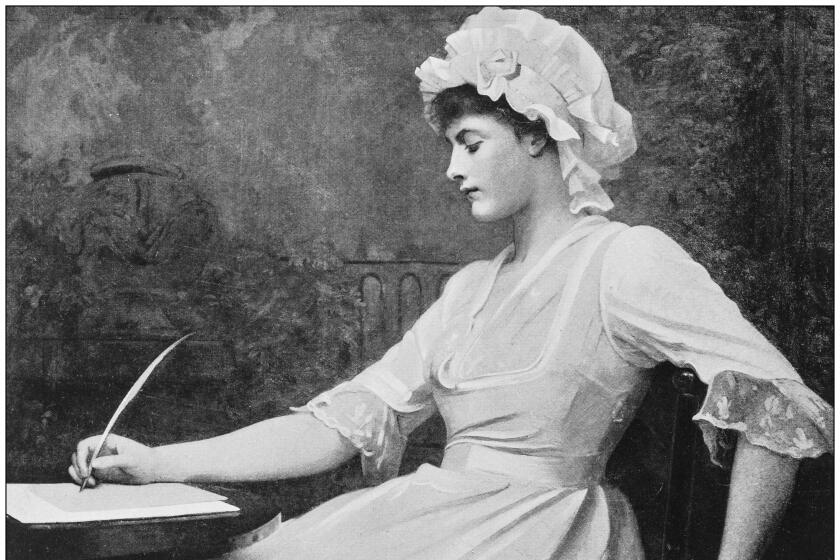Review: A writer braves the stormy seas of baggy historical fiction. Your nautical mileage may vary
History confirms that a town called Rungholt once existed on an island just off the coast of Schleswig-Holstein. Purportedly home to 3,000 people, it sank beneath the sea in a 1362 storm tide known as the Grote Mandrenke (the Great Flood), which killed up to 25,000 across northern Europe.
Mythology has more to say about it: Locals once believed that Rungholt, “the Atlantis of the North Sea,” would rise up once a year, along with its inhabitants, during the spring’s “Schwarze Sonne,” when migrating starlings block the setting sun just above the marshes.
Ursula Hegi’s novels have often dealt with modern Germany, where she was born in 1946, and they have tended toward the tight construction we have come to expect from modern literary fiction. In her new novel, “The Patron Saint of Pregnant Girls,” Hegi has left those shores behind for the murky depths of baggy, picaresque historical fiction.
Drawing on testimonies from rebels, Marjoleine Kars’ riveting “Blood on the River” recounts an 18th century revolt in Guyana that almost succeeded.
“The Patron Saint of Pregnant Girls” begins in 1878, ends a year later and ranges across decades in between. Its setting, a North Sea town called Nordstrand, sports glorious summers and difficult winters, allowing Hegi to simmer a rich stew of fact and fiction, innocents and rogues: a home for wayward mothers-to-be, a traveling circus, a couple gone mad from tragedy and a Greek chorus of Old Women who compete annually for the title of the town’s most elderly.
It’s all too much, on one hand, and for fans of Hegi’s previous work perhaps an unwelcome departure. Few of the stories resolve; some of the plots swell like overblown balloons, only to fizzle when attention shifts. Take the early tale of pregnant Tilli, age 11. After Tilli’s own child is taken away for adoption, she is expected to nurse Wilhelm, youngest child of Kalle and Lotte Jansen. Lotte’s milk dried up after her three older children drowned in a freak wave; she comes to believe that they are somehow still alive, living happy underwater lives on Rungholt.
Tilli’s overwhelming attachment to Wilhelm and the kindly nuns’ efforts to separate them would be enough for a thick novel. But Hegi turns instead to Wilhelm’s father, Kalle, whose grief leads him to run away with the Zirkus — where he meets Sabine, another narrator of still more wayward chapters.
Finally settling in with Kalle and Lotte, we trudge through the seasons, which are mostly damp and depressing. While the nuns nurture their pregnant charges and the Zirkus makes decisions about where to spend the winter, the bereft, estranged parents circle each other. When Kalle first returns to Nordstrand riding a zebra, Lotte — clinging to the belief that her three children still live — repels him.
Maggie O’Farrell uses scant material on the Bard’s family tragedy to examine the struggles of his wife in a beautiful new novel, “Hamnet.”
Kalle gets lonely on the road, however, and returns, choosing to make peace with his wife’s delusions. “They’re playing in the sun,” he tells his wife: “He spins the story for her, embellishes, to lift her from her despair. And be with her.” Gradually, a tale told to gain readmittance to the marriage bed becomes a folie à deux, as the couple plot to row out to Rungholt when it rises from the sea and “rescue” their children.
Their quest closes the book, but does it draw the story to a conclusion? Spoiler alert: If you’re looking for a tidy linear narrative, “The Patron Saint of Pregnant Girls” will not do.
Hegi’s Burgdorf cycle, a quartet of books about a war-weary German town, hewed more closely to a traditional framework. “Patron Saint” certainly has a framework, opening with a freak wave and ending with a desperate search for closure among the survivors. Yet there are so many loose threads along the way (as perhaps in untidy life); Hegi might spend as much time on the birth and upbringing of a dwarf — before dropping her entirely — as on Lotte’s grief.
It’s left partly for the chorus, the Old Women of Nordstrand, to pull together a sense of collective memory and justice. (When the local doctor, who beats his wife and their five daughters, disappears forever, we know the Old Women are responsible.) With its concatenation of vignettes and northern European milieu, the novel’s canvas resembles a feminist take on those hectic old Flemish masterworks — teeming with the faces and bodies of women agonized by childbirth, domestic violence, economic hardship, sexual secrets and more.
Novelist Lynn Steger Strong on the revolutionary passivity of Rachel Cusk, Ottessa Moshfegh and Sally Rooney — how we’ve misread them and what comes next.
That would be all to the good, but it can also be frustrating. We can’t help wanting to hear more about Sister Hildegunde, or Sabine’s relationship with a man known only as the Honey Keeper, or how Lotte became the patron saint of the title. Or, as Hegi perhaps prefers, we can choose to submit to untidiness — to magical descriptions of a liminal landscape, to the rhythms of characters living and dying, thinking and acting in ways far removed from our own and yet intimately, perfectly familiar.
The Patron Saint of Pregnant Girls
Ursula Hegi
Flatiron: 288 pages, $27
More to Read
Sign up for our Book Club newsletter
Get the latest news, events and more from the Los Angeles Times Book Club, and help us get L.A. reading and talking.
You may occasionally receive promotional content from the Los Angeles Times.







